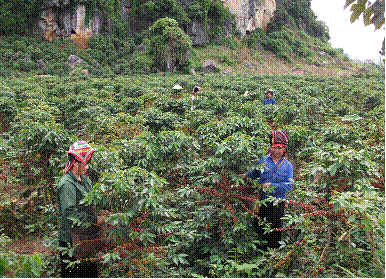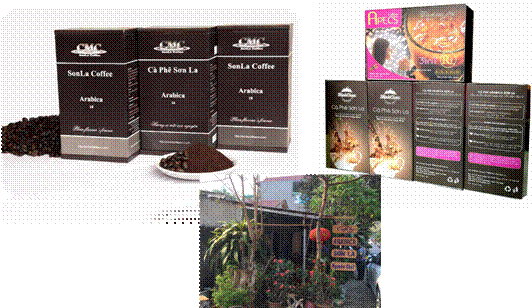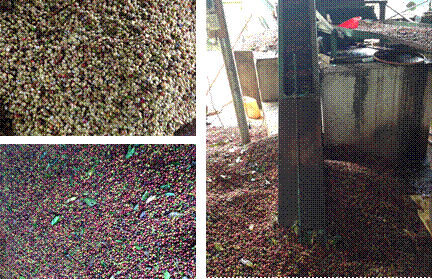On 28 September 2017, The National Office of Intellectual Property has issued Decision No. 3262/QĐ-SHTT on granting Geographical indication registration certificate No. 00058 for the famous “Sơn La” coffee. Sơn La Department of Science and Technology is the organization in charge of managing this GI.
Sơn La province is the second biggest producer of Arabica coffee in Vietnam. “Sơn La” coffee dates back to 1945, when a local started growing coffee trees in his garden. This event is recorded in the book “Sơn La and coffee”. Since then, coffee has been gradually developed, contributing to the incomes of the local minor ethnics, and helping them abandoning their nomadic lifestyle. Coffee production has become a part of the locals’ lives and everyday practices. After more than 70 years of development, Sơn La coffee has become a specialty of Sơn La province and has an established position in the market.

Caffee Son La
“Sơn La” Coffee is made from Arabica coffee, including green coffee, roasted coffee, and coffee powder. Green coffee has long beans, with bean size bigger than 4,75mm, caffeine content from 0,8% to 1,28%, raw protein content from 10,5% to 15%, sugar content from 6,8% to 9,2%. Roasted coffee and coffee powder have brown colour and natural coffee aroma, with no irregular smell. Caffeine content of both roasted and powder coffee is from 1,0% to 1,6%, dissolved substance is from 29% to 36%, raw protein content is from 11,6% to 13,2%. “Sơn La” Coffee when brewed will have puce, transparent colour, the taste is slightly sour and bitter with long aftertaste. The sweet taste and fruity scent are also unique and reputable traits of “Sơn La” Coffee.

The peculiar characteristics and reputation of “Sơn La” Coffee are attributable to the terrain, soil, climate of the geographical area suitable for Arabica coffee, and the experience in the production of the locals.
The geographical area is a high mountainous area, with steep slope and complicated terrain structure, with mountain ranges surrounding the pans, and highlands with the altitude of 600 – 800 metre above sea level. Although the altitude of the area is not ideal, Sơn La is situated at a high latitude of 20o39’ – 22o02’ North. These traits combine into a suitable environment for the development of Arabica trees and create the peculiar characteristics of Sơn La Coffee. The soils used for growing “Sơn La” Coffee are mostly typical ferralitic soils, including brown-red soil on neutral and alkaline magma rock, brown-red soils on limestone, yellow-red soil on clay and on metamorphosed rock, 70 – 100cm of thinkness, pHKCL ranging from 4,5 to 6. This area has soft, nutrious soils with good water absorption andretention. The climate of Sơn La is separated into two distinct seasons: the summer from April to September, and winter from October to March of the next year. High rainfall in the summer helps the coffee trees in their development, bloom and fruition. The average temperature of the area is 16 – 27oC. Amplitude of temperature variation between day and night is 10 – 15oC. Annual average total rainfall is 1.200 – 1.600 mm, concentrating in July to September. Annual average humidity is 80 – 82%.
In addition to the terrain, soil and climate of the area creating the peculiar characteristics of “Sơn La” Coffee, the experience accumulated over time of the locals, such as picking the high quality crop, soils, tending and harvesting procedures, also enhance the quality of “Sơn La” Coffee. The farmers choose the land with slopes of 0 – 150, softness over 60%, good drainage, thickness over 70cm, underground water level exceed 100cm, humus content of the surface should be above 2,5%, and pHKCL of 4,5 – 6. In the tending process, the farmer will plough the soil around the root to create the softness, using leaves and grass to cover the root, use chemical as well as organic fertilizers, cut and shape the coffee trees’ foliage in order to maximize the sunlight received. When the coffee trees are still small, the farmer will grow short-term plants such as legume, bean, peanut, etc. between coffee tree lines, shade the trees by planting white leadtree, water spinach, etc. with reasonable density to ensure ventilation. The farmers will also water the coffee trees’ foliage when there is hoarfrost. The most experience of the farmers in the cultivation is in harvesting. Sơn La farmers will harvest the fruits by hand, picking them instead of plucking the off, and only pick the ripe fruit. This is the technique that differentiate Sơn La’s coffee to those of other. Sơn La coffee trees are smaller, thus this harvesting technique is suitable with the slope terrain of coffee plantations. Processing methods and natural drying by sunlight are also important in ensuring the quality and consistency of Sơn La’s coffee. Although Sơn La farmers used the same processing method as other coffee-producing areas, the coffee here is dried naturally, and therefore does not suffered from mechanical impacts of elements used for coffee drying.

Coffee processing method
In addition, the farmers also invest in and apply technology in the production, which helped “Sơn La” coffee has a high quality, develop sustainably and become more well-known.
Geographical area consists of: communes of Phổng Lái, Chiềng Pha, Phổng Lập, Chiềng Bôm, Nậm Lầu, Bon Phặng and Muổi Nọi of Thuận Châu district; communes of Chiềng Đen, Chiềng Cọ, Hua La, Chiềng Ngần, and Chiềng Sinh of Sơn La city; communes of Mường Chanh, Chiềng Ban, Chiềng Mung, Chiềng Chung, Chiềng Mai, Chiềng Dong, Chiềng Kheo and Phiên Pằn of Mai Sơn district; communes of Púng Bánh, Dồm Cang, Nậm Lạnh and Mường Và of Sốp Cộp district, Sơn La province.
Source: noip.gov.vn






